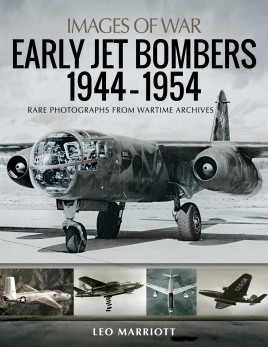Images of War: Early Jet Bombers, 1944-1954
History
This book covers the development of bombers from the beginning of World War II, showing how the advances in technology resulted in better performing aircraft, especially due to more powerful reciprocating engines and the introduction of jet power plants. The earliest development of jet engines occurred in Germany, and they were the first to introduce operational jet fighters and bombers towards the end of the war, although they did not appear in sufficient numbers to make any difference in the outcome. However, the British and Americans also developed jet fighters, and the end of the war, and subsequent occupation of German facilities by advancing American, British, and Soviet forces resulted in a tremendous transfer of German technology to the Allied Powers, the result being an acceleration of the development of jet fighters and bombers in the U.S., Britain, and the Soviet Union. In addition, the development of the atomic bomb significantly affected the design and development of jet bombers after the war.
Aircraft mentioned in the book include the following:
- Germany
- DO-17, HE-111, HE-177, AR-234, ME-262, JU-298
- Britain
- Avro Lincoln, Boeing B-29 “Washington”, DeHavilland Mosquito, E.E. Canberra, Short SA4 (Sperrin), Vickers Valiant, Avro 707, Avro Vulcan, H.P. Victor.
- France
- Leo 451, Aero Centre NC270, Nord 1071, SNCAO SE.4000 (HE-274 carrier) Sud-Ouest S.O. M2, SE-2410 Grognard, Sud-Ouest Vautour.
- United States Air Force
- Boeing B-29, B-50, Convair B-36, XB-60, Douglas XB-42, XB-43, North American B-45, Convair XB-46, Convair XA-44, XB-53, Boeing B-47, KC-97, B-52, Martin XB-48, Douglas A/B-26, Martin B-26H Test, Martin XB-51, B-57, Northrop N9M, XB-35, XB-49, Convair XB-58, Douglas B-66
- United States Navy
- Lockheed P2V, North American AJ, Douglas A3D
- Soviet Union
- Petylyakov PE-8, Tupolev TU-2, B-29/TU-4, Junkers JU-287/OKB, EF-140, EF-150, Ilyushin IL-22, Tupolev TU-77, TU-12, TU-73, TU-14, VK-1, TU-14T, Ilyushin IL-28, IL-30, IL-46, IL-54, Tupolev TU-82, TU-88, TU-16K10 Badger, TU-104 Airliner, TU-95, Myasishchev M-4 Bison, Yak-25, Yak-26, Yak-28.
The Book
The book covers the development of jet bombers by the Germans, Americans, British, Soviets, and French during and after World War II. The main German developments, the Arado AR-234 and the Junkers JU-287 , are thoroughly covered. The relationship between the British Mosquito and the later Canberra development was something I was not aware of. The Short bomber prototypes and the development of the Valiant, Vulcan, Victor and Avro 707 are related in detail. The French developments which eventually led to the Vautour light bomber include details of early French prototypes which used a captured Heinkel HE-274, a four engine modification of the HE-177. The United States section is probably the largest part of the book, mainly because the U.S. developed more bombers postwar than any other country. The text covers mainly technological developments, not the combat records of the aircraft.
Features
The book makes very interesting reading, and I had it finished in a couple of days. The author traced the development of each type, relating it to the political conditions that shaped its progress, especially the Cold War and the introduction of nuclear and hydrogen bombs. Good, clear photographs are provided for each type, and although there are no three view drawings, the book should provide a wealth of information for modelers. I must admit that I learned a lot from this publication, and it has stimulated an interest in building models of some of the more obscure types. Now I’ll have to put an addition on the house to store all of these new models, even though I build 1/72 scale.
Kit Information
There is no kit information as such, although there is a LOT of information that would be useful for anyone interested in building models of these types.
Recommendation
Highly recommended for modelers and non-modelers alike. The author tells the story in a very interesting manner, and provides details to add to the interest of the material. This is a fun read. Don’t miss out on this one.








Comments
Add new comment
This site is protected by reCAPTCHA and the Google Privacy Policy and Terms of Service apply.
Similar Reviews